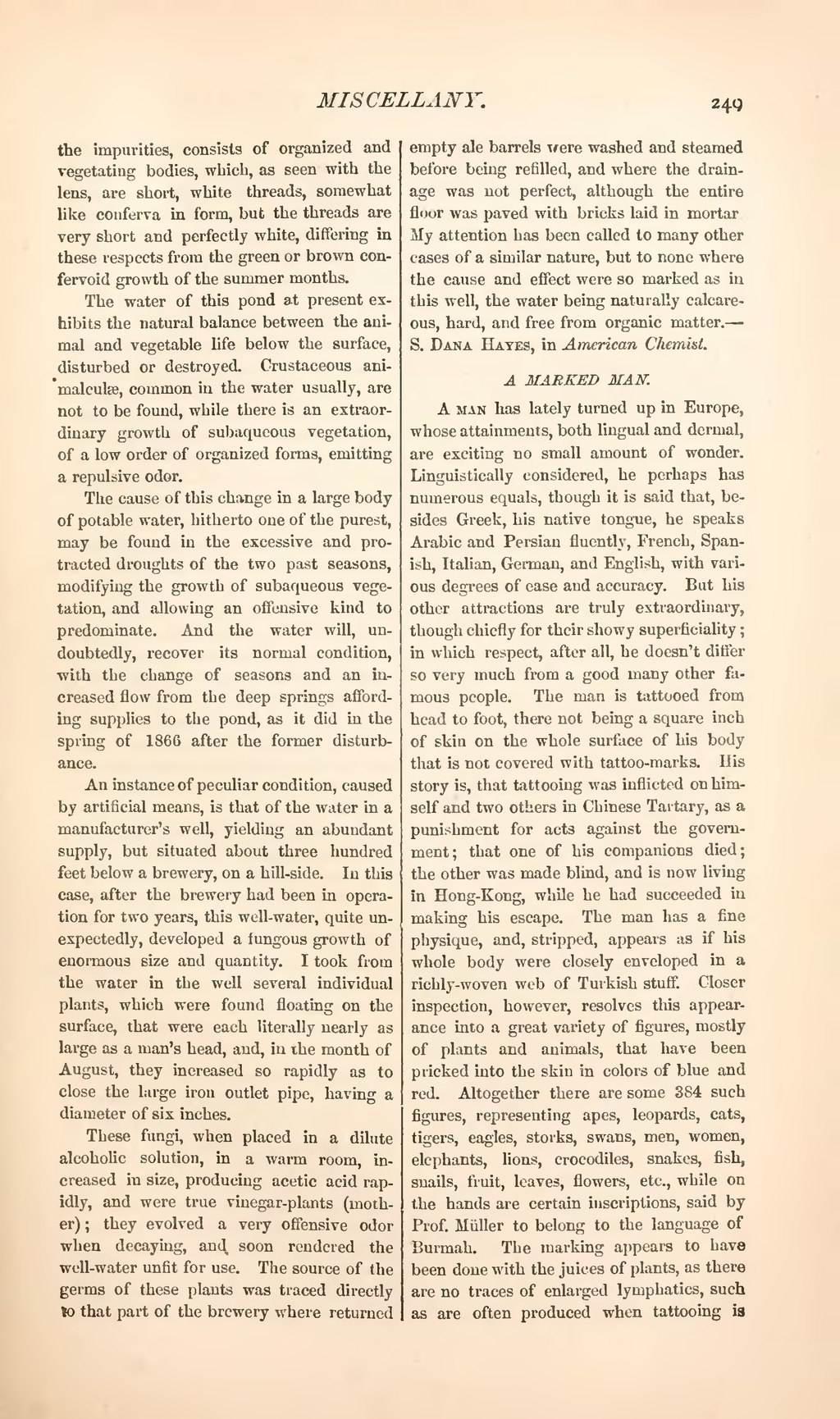the impurities, consists of organized and vegetating bodies, which, as seen with the lens, are short, white threads, somewhat like conferva in form, but the threads are very short and perfectly white, differing in these respects from the green or brown confervoid growth of the summer months.
The water of this pond at present exhibits the natural balance between the animal and vegetable life below the surface, disturbed or destroyed. Crustaceous animalculæ, common in the water usually, are not to be found, while there is an extraordinary growth of subaqueous vegetation, of a low order of organized forms, emitting a repulsive odor.
The cause of this change in a large body of potable water, hitherto one of the purest, may be found in the excessive and protracted droughts of the two past seasons, modifying the growth of subaqueous vegetation, and allowing an offensive kind to predominate. And the water will, undoubtedly, recover its normal condition, with the change of seasons and an increased flow from the deep springs affording supplies to the pond, as it did in the spring of 1866 after the former disturbance.
An instance of peculiar condition, caused by artificial means, is that of the water in a manufacturer's well, yielding an abundant supply, but situated about three hundred feet below a brewery, on a hillside. In this case, after the brewery had been in operation for two years, this well-water, quite unexpectedly, developed a fungous growth of enormous size and quantity. I took from the water in the well several individual plants, which were found floating on the surface, that were each literally nearly as large as a man's head, and, in the month of August, they increased so rapidly as to close the large iron outlet pipe, having a diameter of six inches.
These fungi, when placed in a dilute alcoholic solution, in a warm room, increased in size, producing acetic acid rapidly, and were true vinegar-plants (mother); they evolved a very offensive odor when decaying, and soon rendered the well-water unfit for use. The source of the germs of these plants was traced directly to that part of the brewery where returned empty ale barrels were washed and steamed before being refilled, and where the drainage was not perfect, although the entire floor was paved with bricks laid in mortar. My attention has been called to many other cases of a similar nature, but to none where the cause and effect were so marked as in this well, the water being naturally calcareous, hard, and free from organic matter.—S. Dana Hayes, in American Chemist.
A MARKED MAN.
A man has lately turned up in Europe, whose attainments, both lingual and dermal, are exciting no small amount of wonder. Linguistically considered, he perhaps has numerous equals, though it is said that, besides Greek, his native tongue, he speaks Arabic and Persian fluently, French, Spanish, Italian, German, and English, with various degrees of ease and accuracy. But his other attractions are truly extraordinary, though chiefly for their showy superficiality; in which respect, after all, he doesn't differ so very much from a good many other famous people. The man is tattooed from head to foot, there not being a square inch of skin on the whole surface of his body that is not covered with tattoo-marks. His story is, that tattooing was inflicted on himself and two others in Chinese Tartary, as a punishment for acts against the government; that one of his companions died; the other was made blind, and is now living in Hong-Kong, while he had succeeded in making his escape. The man has a fine physique, and, stripped, appears as if his whole body were closely enveloped in a richly-woven web of Turkish stuff. Closer inspection, however, resolves this appearance into a great variety of figures, mostly of plants and animals, that have been pricked into the skin in colors of blue and red. Altogether there are some 384 such figures, representing apes, leopards, cats, tigers, eagles, storks, swans, men, women, elephants, lions, crocodiles, snakes, fish, snails, fruit, leaves, flowers, etc., while on the hands are certain inscriptions, said by Prof. Miller to belong to the language of Burmah. The marking appears to have been done with the juices of plants, as there are no traces of enlarged lymphatics, such as are often produced when tattooing is
